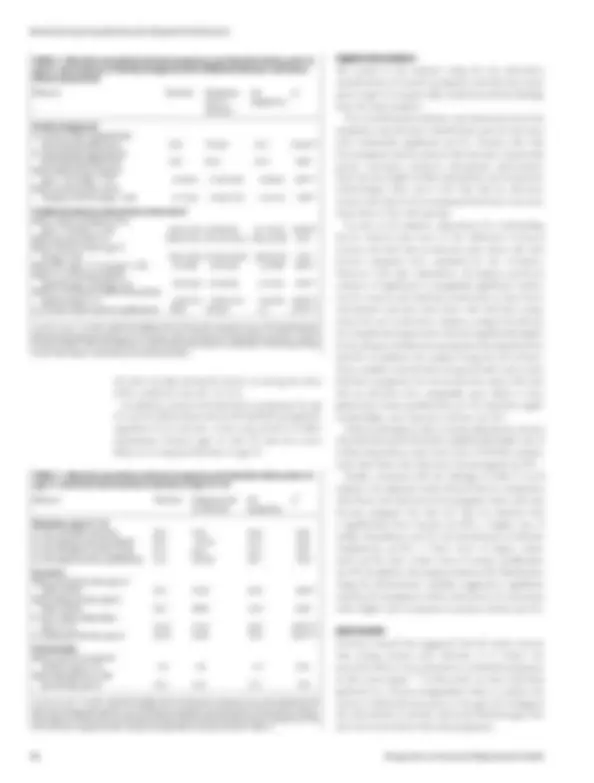





Study with the several resources on Docsity

Earn points by helping other students or get them with a premium plan


Prepare for your exams
Study with the several resources on Docsity

Earn points to download
Earn points by helping other students or get them with a premium plan
Community
Ask the community for help and clear up your study doubts
Discover the best universities in your country according to Docsity users
Free resources
Download our free guides on studying techniques, anxiety management strategies, and thesis advice from Docsity tutors
These findings raise the issue of the extent to which the decision to have an abortion has advantages for the woman.
Typology: Slides
1 / 7

This page cannot be seen from the preview
Don't miss anything!




CONTEXT: Young women frequently cite concerns about the effects of unplanned pregnancies on future life course outcomes, including education, employment and relationships, as reasons for seeking abortion. There is relatively little evidence as to whether abortion leads to improved life course outcomes for young women who choose this option.
METHODS: Data from 492 women participating in a 25-year longitudinal study of a New Zealand birth cohort were used in regression models that examined the relationship between pregnancy and abortion history prior to age 21 and selected social and economic outcomes at ages 21–25.
RESULTS: Compared with young women who became pregnant before age 21 but did not seek an abortion, young women who had an abortion had significantly better outcomes on six out of 10 measures spanning education, income, welfare dependence and domestic violence. Adjustment for confounding factors indicated that most of these differences were explained by family, social and educational characteristics that were present prior to pregnancy. Nonetheless, even after adjustment for confounding factors, young women who had abortions had higher levels of subsequent educational achievement than those who became pregnant but did not have abortions.
CONCLUSIONS: Abortion may mitigate some effects of early unplanned pregnancy. However, further study of its potential risks and benefits is needed so that women can make fully informed decisions as to whether to terminate unintended pregnancies. Perspectives on Sexual and Reproductive Health, 2007, 39(1):6–12, doi: 10.1363/
In research into why young women seek abortions, some of the more frequently given reasons relate to the edu- cational, economic and partnership consequences of unwanted or mistimed pregnancy. For example, Broen et al. 1 interviewed women at three time points following an abortion, and found that concerns about the effect of having a child on education, career, finances and relation- ships were rated as important reasons for having an abortion. Similarly, Finer et al.^2 reported that frequently, young women who had abortions stated that they felt unprepared for motherhood, and cited interference with educational opportunities as a primary reason for choos- ing this option. Seventy-five percent of abortion patients surveyed by Torres and Forrest^3 listed interference with education or being unable to afford a baby as a primary reason for having an abortion, while 50% listed potential relationship problems. Sihvo et al. 4 reported that for women younger than 25, concerns about education and relationship status were the most important determi- nants of the decision to have an abortion. These findings raise the issue of the extent to which the decision to have an abortion has advantages for the woman. Indirect evidence suggests possible benefits of abortion for subsequent life course outcomes. In partic- ular, a substantial literature has linked teenage parent- hood with educational underachievement,5–7^ poverty,8– welfare dependence,9,11^ domestic violence^12 and impaired
partnership relationships.7,12^ For example, Hofferth, Reid and Mott^5 found that teenage mothers completed 1.9–2.2 fewer years of schooling than women who first gave birth after age 30. Similarly, Moore et al.^8 reported that lower ages at first birth were strongly associated with increasing risks of poverty for women at age 27, and Grindstaff^9 showed that women who gave birth as adoles- cents were more likely than other mothers to become welfare-dependent. Finally, Harrykissoon, Rickert and Wiemann^12 found that adolescent mothers were at increased risk for intimate partner violence and relation- ship problems. One might assume that the adverse outcomes experi- enced by adolescent mothers are largely or wholly the consequence of mistimed or unwanted pregnancies, and that the adversities associated with teenage pregnancy may therefore be mitigated by abortion. However, only a limited number of studies have directly examined whether young women who have abortions have better life course outcomes than young women who become pregnant but do not seek abortions. Zabin, Hirsch and Emerson 13 found that pregnancy clinic attendees who had abortions were more likely to complete high school and more likely to be employed two years later than were those who carried their pregnancies to term or had negative pregnancy tests. Similarly, Bailey et al.^14 found that Brazilian adolescents who had abortions were more
By David M. Fergusson, Joseph M. Boden and L. John Horwood
David M. Fergusson is professor and executive director, Joseph M. Boden is a research fellow and L. John Horwood a senior research fellow, all with the Christchurch Health and Development Study, Christchurch, New Zealand.
6 Perspectives on Sexual and Reproductive Health
likely than those not having abortions to be attending school one year later. In this article, we examine life course outcomes follow- ing abortion before age 21 in a birth cohort of young women in New Zealand studied to the age of 25. In New Zealand, the provision of legal abortion is determined by the Contraception, Sterilisation and Abortion Act of 1977, and is overseen by the Abortion Supervisory Committee. Before a woman may undergo a legal abortion, she must approach her doctor and receive a referral to two special- ist consultants. The consultants must agree that one of three conditions is met: The pregnancy would seriously harm the life or the physical or mental health of the woman or baby; the pregnancy is the result of incest; or the woman is severely mentally handicapped. An abor- tion will also be considered on the basis of age or when the pregnancy is the result of rape. 15 The aims of this analysis were to examine the extent to which young women who had an abortion prior to age 21 showed advantaged outcomes when compared with women who became pregnant but did not seek an abortion. We hypothesized that when due allowance was made for prepregnancy factors, women who had an abortion would have relatively advantaged educational, economic and related outcomes. The analysis also com- pares women having an abortion by age 21 with those not becoming pregnant by 21. We hypothesized that when due allowance was made for prepregnancy factors, these two groups would have similar educational and related outcomes.
METHODS Study Design The data used in these analyses came from the Christ- church Health and Development Study, a longitudinal study of a cohort of 1,265 children born in 1977 in the Christchurch, New Zealand, urban region who were studied from birth to age 25. The analyses were based on the 492 female participants for whom full information on pregnancy history and educational, income, welfare dependence, employment and partnership outcomes to age 25 was available. This sample represented 78% of the original cohort of females. All data were collected on the basis of signed parental consent and, from age 14 onward, signed consent of the cohort members themselves. All phases of data collection had ethical approval from the Canterbury Ethics Committee. Sample members were interviewed at ages 15, 16, 18 and 21 about their pregnancy and abortion experience since the previous assessment. These reports showed that 125 women (25% of the sample) had had at least one pregnancy by age 21. A total of 172 pregnancies were reported, of which 55% had resulted in a live birth, 31% had been terminated by abortion and 14% had ended in miscarriage. For our main analysis, we classified participants into three mutually exclusive groups: those who had had an
abortion before age 21 (48 women); those who had had a pregnancy but not an abortion before age 21 (77); and those who had never become pregnant before age 21 (367). However, this method of classification is not without limitations. In particular, 11 women who had had abortions also had had live births. Furthermore, the classification does not distinguish women who had had a live birth from those who had had a miscarriage. To address these issues, we devised a series of classification schemes to examine the sensitivity of the analysis to alternative representations of an individual’s pregnancy and abortion history. In addition, all analyses were conducted including and excluding women whose only pregnancy had ended in miscarriage (11 participants). To cross-validate the self-reported data, we compared our estimates with officially recorded pregnancy and abortion statistics for New Zealand. 16 These comparisons suggested some underreporting of abortion. The ob- served rate of abortion by age 21 in the cohort (108 per 1,000) was 88% of the rate expected on the basis of popu- lation figures (123 per 1,000). However, this difference was not statistically significant.
Outcome Measures We examined 10 measures, assessed at age 25, spanning educational, economic and partnership outcomes. dEducational.Cohort members were questioned concern- ing their history of enrollment in tertiary (i.e., any post- secondary) education and training, and concerning any educational or vocational degrees or certification ob- tained since age 21. This information was used to classify participants on four dichotomous measures of educa- tional achievement between ages 21 and 25: attendance at university; completion of a university degree (bachelor’s level or above); enrollment in any form of tertiary edu- cation or training; and attainment of any tertiary educa- tional or vocational qualification. dEconomic.Sample members were asked to estimate their personal gross income from all sources over the previous 12 months. For participants living alone or still living with parents or other family members, this estimate was also used as a measure of family income, because it repre- sented the portion of household income over which the participant presumably had some decision-making power. For participants who were married or living with a romantic partner, who presumably made joint decisions over joint incomes, an estimate of family income was obtained by asking about the partner’s gross income during the previous 12 months, and adding this to the personal income estimate. In addition, women were questioned about their receipt of social welfare benefits since age 21. The propor- tion who reported receiving an unemployment benefit, domestic purposes benefit (for the support of single- parent families with dependent children), or sickness or invalids benefit at any point in the period served as an outcome measure. Participants were also questioned
Volume 39, Number 1, March 2007 7
comparisons between groups.* A similar procedure was used to examine the associations between covariates and the measure of pregnancy and abortion status. To adjust the observed associations for confounding, the regression models were extended to include the covariate factors. †^ In fitting these models, both forward and backward methods of covariate selection were used to identify the best fitting and most parsimonious model representation for each outcome. From the parameters of the final fitted model for each outcome, we constructed tests of the adjusted association with pregnancy and abortion status, as well as tests of pairwise differences between groups. Estimates of the adjusted means or percentages for each outcome were obtained using the methods described by Lee. 27 Finally, as noted above, the complicated pregnancy history of a number of cohort members led to some classification issues. To examine the sensitivity of the analysis to the way in which the woman’s pregnancy and abortion history had been classified, we reanalyzed the data, using two alternative classification approaches. In one, we based the classification on the woman’s first pregnancy only; in the other, we used pregnancy without abortion and pregnancy with abortion as correlated dichotomous predictor variables to take into account the possible overlap between abortion and pregnancy without abortion. All analyses were then repeated exclud- ing the 11 women whose only pregnancy had resulted in miscarriage.
RESULTS Bivariate Analyses dOutcome measures. For all outcomes, women who had
had a pregnancy and had not sought an abortion fared significantly less well than those who had not had a pregnancy (Table 1). Furthermore, in six out of the 10 comparisons, women who had had an abortion had significantly advantaged outcomes when compared with those who had had a pregnancy but not an abortion: They were significantly more likely to have attended university, to have gained a university degree and to have gained a tertiary qualification other than a university degree, and were less likely to have been welfare-dependent. They also had significantly higher mean personal income and experienced a significantly lower mean level of partner violence than those who had become pregnant but not sought an abortion. Finally, the bivariate analyses revealed that in seven out of the 10 comparisons, those who had had an abortion had outcomes that were not significantly different from outcomes among those who had had no pregnancy by age
abortion or had not become pregnant by age 21, those who had been pregnant but not sought an abortion
tended to come from educationally and economically disadvantaged backgrounds (Table 2, page 10). They had significantly lower intelligence scores and levels of educational achievement in childhood, and were signifi- cantly more likely to leave school without educational qualifications.
Adjusted Analyses After adjustment for background factors, women who had had an abortion did not differ from others who had become pregnant in eight of the 10 comparisons (Table 3, page 10). However, the proportion of women with tertiary qualification attainment was 1.7 times as high among those who had had an abortion before age 21 as among those who had been pregnant but had not sought an abortion (95% confidence interval, 1.1–2.6), and the proportion who attained a university degree was
TABLE 1. Bivariate associations between women’s pregnancy and abortion history prior to age 21 and social and economic measures at ages 21–25, Christchurch Health and Development Study, New Zealand Measure Abortion (N=48)
Pregnancy but no abortion (N=77)
No pregnancy (N=367)
c^2
Education, ages 21– % who attended university 29.2 11.7†,‡ 39.6 18.61*** % who gained university degree 18.8 3.9†,‡ 31.3 19.54*** % who enrolled in tertiary study 50.0 39.0† 57.8 21.33*** % who gained tertiary qualification 41.7 22.1†,‡ 52.0 9.20* Economic Mean personal income, age 25 (000s of NZ$; range, 0–120) 24.2† (13.7) 17.7†,‡ (15.2) 31.7 (19.2) 20.63*** Mean family income, age 25 (000s of NZ$; range, 2.1–150) 43.6 (29.3) 35.9† (24.1) 53.1 (34.0) 8.31** % ever welfare-dependent, ages 21–25 54.2† 68.8†,‡ 25.1 55.88*** % employed full-time, age 25 41.7† 30.0† 73.6 56.95*** Partnership§ Mean exposure to partner violence, age 24– (range, 0–21) 2.0 (2.7) 3.2†,‡ (3.6) 1.8 (2.5) 11.38*** Mean dissatisfaction with partnership, age 25 (range, 10–29) 13.6 (3.2) 14.4† (4.8) 12.5 (3.2) 7.80** *p<.05. **p<.01. ***p<.001. †Significantly different from the figure for no pregnancy at p<.05. ‡Significantly dif- ferent from the figure for abortion at p<.05. §Based on participants who reported an intimate partner relation- ship at ages 24–25 (42 women who had had an abortion, 69 who had had a pregnancy but no abortion, and 307 who had had no pregnancy). Note: Figures in parentheses are standard deviations.
*Specifically, a Wald test of the joint hypothesis that B 1 =B 2 =0 led to a chi- square test of significance (with 2 degrees of freedom) of the overall association between pregnancy history and the outcome. Similarly, the test of significance on the parameter B 1 provided a test of the pairwise difference between those who had had an abortion and those who had never been pregnant, the test on the parameter B 2 provided a test of the pairwise comparison between those who had been pregnant but had not sought an abortion and those who had never been pregnant, and the difference between the parameters B 1 and B 2 provided a test of the pairwise comparison between women who had had an abortion and other women who had had a pregnancy. †For continuous outcomes, these models were of the general form Yi=B 0 1 B 1 X (^) 1i 1 B 2 X2i 1 SB (^) jZ (^) ji 1 U (^) i; for dichotomous outcomes, logit (Yi)=B 0 1 B 1 X (^) 1i 1 B 2 X (^) 2i 1 SB (^) jZ (^) ji, where Z (^) j were the covariate factors.
Volume 39, Number 1, March 2007 9
2.8 times as high among the former as among the latter (95% confidence interval, 1.2–6.3). In addition, women who had had no pregnancy by age 21 were less likely than women who had had a pregnancy, regardless of its outcome, to have any period of welfare dependency between ages 21 and 25, and were more likely to be employed full-time at age 25.
Supplementary Analyses The results of the analyses using the two alternative classifications of women’s pregnancy and abortion status prior to age 21 were generally consistent with the findings from the main analyses. First, in all bivariate analyses, associations between the pregnancy and abortion classification and all outcomes were statistically significant (p<.01). Women who had been pregnant and not had an abortion had consistently poorer outcomes (reduced educational achievement, lower income, higher welfare dependence, poorer partner relationships) than those who had had an abortion; women who had not been pregnant had better outcomes than either of the other groups. Second, in all analyses, adjustment for confounding factors showed that most of the differences between women who had had an abortion and others who had become pregnant were explained by the covariates. However, even after adjustment, all analyses produced evidence of significant or marginally significant tenden- cies for women who had had an abortion to have better educational outcomes than those who had had a preg- nancy but not an abortion. Analyses using both alterna- tive classification approaches showed significantly higher levels of degree attainment among those having abortions (p£.05). In addition, the analysis using the two dichoto- mous variables showed that compared with women who had had a pregnancy but not an abortion, those who had had an abortion were marginally more likely to have gained any tertiary qualification (p<.10) and had a signif- icantly higher rate of partner violence (p<.05). Third, in all analyses, after covariate adjustment, women who had had an abortion had a significantly higher rate of welfare dependence and a lower rate of full-time employ- ment than those who had never been pregnant (p<.01). Finally, consistent with the findings in Table 3, in all analyses, the adjusted results showed that in comparison with those who had never been pregnant, those who had become pregnant but had not had an abortion had a significantly lower income (p<.001), a higher rate of welfare dependence (p<.01), less involvement in full-time employment (p<.01), a lower level of degree attain- ment (p<.05) and a lower level of tertiary qualification (p<.05). In addition, the analyses based on the classification using the dichotomous variables suggested a significant tendency for pregnancy without abortion to be associated with a higher rate of exposure to partner violence (p<.01).
DISCUSSION Previous research has suggested that the major reasons that young women seek abortion is to reduce the perceived effects of an unwanted or mistimed pregnancy on life course plans. 1–4^ In this article, we have used data gathered in a 25-year longitudinal study to explore the extent to which abortion prior to the age of 21 mitigated the educational, economic and social disadvantages that have been associated with early pregnancy.
TABLE 2. Bivariate associations between pregnancy and abortion history prior to age 21 and measures of family background and childhood behavior and educa- tional achievement Measure Abortion Pregnancy but no abortion
No pregnancy
c^2
Family background % whose mother lacked formal educational qualifications 52.0 74.4†,‡ 43.7 22.45*** % whose father lacked formal educational qualifications 54.3 61.6 45.5 6.85* Mean family living standard, ages 1–10 (range, 1–5)§ 2.9 (0.5) 3.2†,‡ (0.4) 2.8 (0.4) 8.97** Mean socioeconomic status category at birth (range, 1–6)§ 3.7 (1.6) 4.3†,‡ (1.3) 3.3 (1.4) 7.06** Childhood behavior/educational achievement Mean conduct problems score, ages 7–9 (range, 41–83) 50.1† (7.0) 51.8† (8.4) 47.1 (5.0) 18.92*** Mean IQ score, ages 8–9 102.8 (15.2) 97.7†,‡ (16.1) 104.2 (15.6) 4.13* Mean TOSCA†† score, age 13 (range, 0–69) 36.2 (13.9) 31.3†,‡ (15.8) 38.0 (14.2) 4.22* Mean GPA, ages 11–13 (range, 1–5)§ 2.4 (0.8) 2.6† (0.8) 2.2 (0.8) 8.02** Mean no. of school problems reported, age 15 (range, 0–4) 0.4† (0.8) 0.4† (0.8) 0.1 (0.5) 8.45** Mean no. of School Certificate‡‡ passing grades (range, 0–7) 2.6† (2.3) 1.8†,‡ (2.1) 4.0 (2.0) 36.07*** % who left school without qualifications 28.0† 44.9†,‡ 6.1 67.67*** *p<.05. **p<.01. ***p<.001. †Significantly different from the figure for no pregnancy at p<.05. ‡Significantly dif- ferent from the figure for abortion at p<.05. §Lower means correspond to more positive outcomes. ††Test of Scholastic Abilities. ‡‡School Certificate is a national series of examinations usually taken in the third year of high school. Note: Figures in parentheses are standard deviations.
TABLE 3. Adjusted associations between pregnancy and abortion history prior to age 21 and social and economic measures at ages 21– Measure Abortion Pregnancy but no abortion
No pregnancy
c^2
Education, ages 21– % who attended university 36.2 22.0 36.0 4. % who gained university degree 26.7 9.7†,‡ 27.3 5. % who enrolled in tertiary study 57.7 64.4 55.3 2. % who gained tertiary qualification 51.4 30.4†,‡ 49.7 7.65* Economic Mean personal income, age 25 (000s of NZ$) 25.5 21.9† 30.8 9.64** Mean family income, age 25 (000s of NZ$) 44.3 38.8† 52.8 6.05* % ever welfare-dependent, ages 21–25 52.3† 57.4† 28.0 26.97*** % employed full-time, age 25 44.2† 35.9† 72.9 36.21*** Partnership§ Mean exposure to partner violence, age 24–25 1.8 2.6 1.9 0. Mean dissatisfaction with partnership, age 25 13.3 13.4 12.7 1. *p<.05. **p<.01. ***p<.001. †Significantly different from the figure for no pregnancy at p<.05. ‡Significantly dif- ferent from the figure for abortion at p<.05. §Based on participants who reported an intimate partner relation- ship at ages 24–25 (42 women who had had an abortion, 69 who had had a pregnancy but no abortion, and 307 who had had no pregnancy). Note: Analyses are adjusted for all measures shown in Table 2.
Abortion Among Young Women and Subsequent Life Outcomes
10 Perspectives on Sexual and Reproductive Health
Acknowledgments The research on which this article is based was funded by grants from the Health Research Council of New Zealand, the National Child Health Research Foundation, the Canterbury Medical Research Foundation and the New Zealand Lottery Grants Board.
Author contact: david.fergusson@chmeds.ac.nz
Abortion Among Young Women and Subsequent Life Outcomes
12 Perspectives on Sexual and Reproductive Health